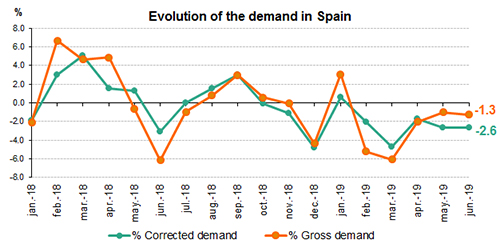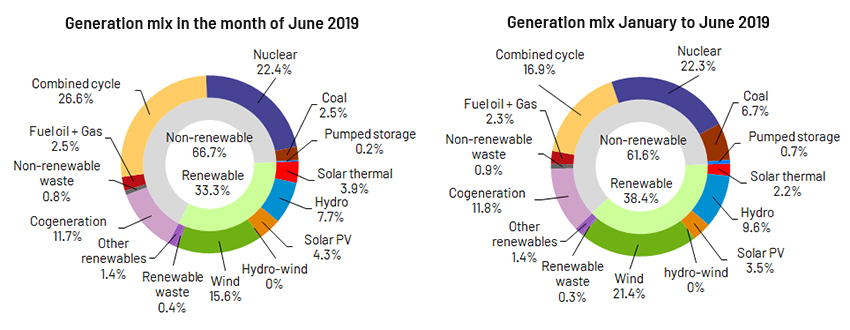Discover what Red Eléctrica is, what we do, and why we are the backbone of the electricity system in Spain and the ecological transition.
Demand for electricity in Spain falls 1.3% in June
- Demand for electricity increases in the Balearic Islands and the Canary Islands.
- 33.3% of the total generation came from renewable sources and 55.9% of the total was generated using technologies that produce zero CO2 emissions.
- Wind energy generated 27,229 GWh of electricity in the first half of the year (21.4% of the national total) and was only surpassed by nuclear, which produced 22.3% of the total production.
The demand for electrical energy nationwide in the month of June is estimated at 21,329 GWh, 1.3% lower than that registered in the same month last year. After having factored in the influence of seasonal and working patterns, electrical energy demand fell 2.6% compared to June 2018.
In the first six months of 2019, the demand for electricity is estimated at 130, 800 GWh, 2.1% less than in 2018. Again, after having factored in the influence of seasonal and working patterns, demand for electricity is 2.2% less than that registered in the same period last year.

During the first half of the year another trend has also been observed: the decoupling of the variation in energy demand from Spain’s GDP as a result, among other reasons, of the increase in energy efficiency and changes in consumption habits. This new scenario, which we are seeing in other European countries such as France and Germany, has been analysed by Red Eléctrica in its study entitled ‘Electricity demand and economic activity: A Paradigm shift?’ (just available in Spanish).
During the month of June and according to estimated data, generation coming from renewable energy sources represented 33.3% of the total production. 55.9% of electricity generation during the month was obtained using technologies which produce zero CO2 emissions.
With information available as at the time of this press release, wind energy generation in June reached 3,247 GWh, 23.4% up on the same period last year, and accounts for 15.6% of the total production. Furthermore, wind energy, with a total production of 27,229 GWh since the start of the year, closed the period from January to June as the second technology that contributed the most to the generation mix, with 21.4% of the total.

The demand for electrical energy in the peninsular electricity system falls by 1.4%
The demand for electrical energy in the peninsular electricity system in the month of June is estimated at 20,043 GWh, 1.4% lower than that registered in the same month last year. After having factored in the influence of seasonal and working patterns, electrical energy demand fell by 2.9% compared to June 2018.
In the first half of 2019, the demand for electricity on the Spanish Peninsula is estimated at 123,508 GWh, 2.2% less than in 2018. Again, after having factored in the influence of seasonal and working patterns, the demand for electricity is 2.4% lower than that registered in the same period last year.
During this month and according to estimated data, 34.6% of the peninsular generation came from renewable energy sources and 58.6% was obtained using technologies which produce zero CO2 emissions. On the other hand, wind energy registered 3,173 GWh, 23.3% higher than in June last year, and contributed 16.1% to the generation mix.
The demand for electrical energy increases in the Balearic Islands and in the Canary Islands
In the Balearic Islands, the demand for electricity in June is estimated at 542,429 MWh, 1.1% higher than that recorded in the same month last year. After having factored in the influence of seasonal and working patterns, the figure increased by 1% with respect to June 2018. In the first half of 2019, the demand on the Balearic Islands is estimated at 2,786,967 MWh, which is 0.3% less than in 2018.
Combined cycle, with 41.4% of the total production, was the leading source used for electricity generation in the Balearic Islands. Renewables and those technologies that produce zero CO2 emissions accounted for 7.3% of the total generation on the Balearic Islands.
For its part, in the Canary Islands the demand for electricity is estimated at 708,335 MWh, 0.1% up on that registered in June 2018. After having factored in the influence of seasonal and working patterns, the figure remains unchanged compared to that of the same month last year. From January to June, demand on the Canary Islands is estimated at 4,304,150 MWh, showing an increase of 0.2% compared to the same period in 2018.
In June and according to estimated data, combined cycle was the leading technology in the Canary Islands generation mix, contributing a share of 31.6%. Renewables and those technologies that produce zero CO2 emissions accounted for 13.1% of the total generation on the Canary Islands.
Visit our Daily Balance Report for more information on the peninsular, Balearic Islands and Canary Islands systems as at the close of June.











